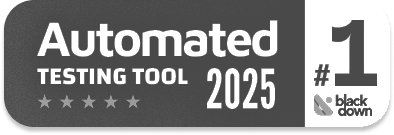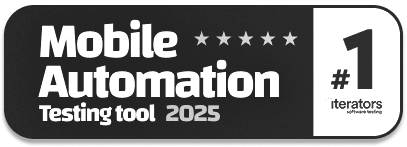Is QA More Cost-Effective Thanks to Automation?
|
|
Software quality assurance (QA) is advancing, and automation plays a pivotal role in bringing efficacy, precision, and cost-efficiency to QA. There is an increasing necessity for faster releases, better software quality, and stronger systems, which has driven organizations to invest in new methods. One of the most impactful evolutions in the recent history of testing is this transition from manual QA to automated QA. But is this change in any way more cost-effective?
Key Takeaways
- Automation reduces long-term QA costs by eliminating repetitive manual tasks and increasing overall efficiency.
- It accelerates software release cycles by integrating seamlessly with CI/CD pipelines and enabling faster feedback.
- Automated testing scales effortlessly as applications grow, without the need for proportional increases in team size.
- Achieving success with automation requires a strategic approach, including the right tools, skilled teams, and maintainable frameworks.
- Despite initial costs, automation delivers a strong return on investment within 6 to 12 months by improving accuracy and reducing delays.
Let us understand whether QA is more cost-effective by analyzing the costs, benefits, implementation challenges, ROI, and future outlook of automated QA.
What is Quality Assurance?
Quality Assurance is a systematic, proactive process that is employed to ensure a product is free from defects, wherein we ensure every aspect of it is right from how reliability, performance, usability, to security of the product work. QA is not testing, it is about building quality into the life cycle of development from the outset.
Quality Assurance is different from conventional testing which is reactive and issue based and it prevents failures before they happen. It covers the whole development life cycle from requirements gathering to deployment, making processes efficient, and consistently delivering a high quality of software. Understand the difference between QA and QC: Quality Assurance vs. Quality Control: Know The Difference.
Key Components of QA
- Requirement Review: Ensuring the documented requirements are unambiguous, complete, and testable.
- Test Planning: Developing overall test plans for the software, including scope, resources, schedule, and risk.
- Test Execution: Carrying out the planned tests to validate functionality, performance, and other quality attributes.
- Defect Tracking and Management: Logging, triaging, and handling defects through the development and post-release cycle.
- Process Improvement: Iterating on development and testing procedures based on measurement, feedback, and experiences.
Manual vs. Automated QA
Quality Assurance can be performed in two fundamental ways: Manual and Automated. Each approach has distinct advantages and use cases, and in many mature QA environments, they are used in tandem for maximum effectiveness.
- Manual QA: Manual testing is where humans manually test the test cases without using any script or tool. Testers use the application as a real user would and report what situations an automated tool might not have thought of. Read more: Manual Testing: A Beginner’s Guide.
- Automated QA: Automated testing employs software tools and scripts to perform test cases by executing tests automatically, often as part of the software development pipeline (CI/CD). It’s a mechanism to increase the speed, consistency, and coverage of tests by robotizing the most repetitive and time-consuming cases. More about it: What is Automation Testing?
Automation aims to reduce human error, increase test coverage, accelerate testing cycles, and ultimately lower costs.
Breakdown of QA Costs
Software quality assurance is a very much needed requirement to ensure the delivery of high-performance and reliable applications. But unless QA efforts are also efficient, it is important to know where it is being absorbed. QA costs can be categorised into several dimensions, each playing out in its own way depending on your QA approach (manual vs. automated, in-house vs. outsourced, tool-based vs. exploratory, etc.). Read more on What is the Cost of Quality in Software Testing?
Personnel Costs
Labor costs include spending for the salaries, benefits, and recruitment of QA engineers and testers. Manual testing normally requires more headcount as your app grows, which raises your cost of labor across the board. Training and upskilling investment is also a must-do in order to ensure that QA professionals are in step with changing tools and practices. Experienced automation engineers can be quite expensive to hire. Read: Top QA Tester’s Skills in 2025.
Tooling Costs
QA and testers need test management, automation, bug tracking, and performance analysis tools. Open-source tools like Selenium or Cypress are free, but they require time and effort to be set up and maintained. There are AI agents, such as testRigor, with more features and better support. There are other commercial tools where you have to weigh functionality, scalability, budget, and more.
Infrastructure Costs
For automation you need to build infrastructure such as test infrastructure, cloud based device farms and CI/CD pipelines. Companies might also have to purchase servers/containers/cloud machines not provided by a third party for parallel, cross-platform testing. Those assets help to provide test repeatability, scalability, and speed, though at the cost of continued running operational. You need a platform that can handle all those tests running quickly and often.
Maintenance Costs
Routine maintenance of automation scripts is necessary to keep them in sync with the evolving UI, workflows, and logic. After a while, script maintenance itself gets cumbersome, especially when the tests are frail or not well written. Maintaining reliable, consistent automation takes ongoing management. When maintenance is ignored, the false positives are increased, and the test confidence is decreased. Read: Decrease Test Maintenance Time by 99.5% with testRigor.
Opportunity Costs
Delays in testing can push back release dates, causing missed market opportunities and reduced competitiveness. Bugs that slip into production due to insufficient QA can harm user trust and revenue. QA bottlenecks in the development pipeline slow down overall team velocity. These hidden costs often have a bigger financial impact than direct QA expenses.
How Automation Reduces QA Costs
Automation plays a crucial role in driving down QA costs while improving overall efficiency and software quality. By taking over repetitive tasks and scaling seamlessly with growing applications, it empowers teams to test faster, smarter, and more thoroughly. Read: Total Cost of Ownership(TCO) of Test Automation.
Reduces Repetitive Work
Just think of a tester who gets to run the same 2-hour regression suite, over and over again on a daily basis, so drab, non-productive, and costly. Now imagine automation performing that same job and completing it in minutes, with not a single complaint. This not only chops off hours from the clock but frees up testers to discover crucial edge cases that machines can’t imagine.
Real-world savings: One automated daily test can win back more than 480 hours of lost time each year, so teams have more time for innovation.
Scales with Application Growth
As software gets bigger, so do the test cases, more features, more edge cases, and more complexity. It’s just not cost-effective to hire a tester for every new module, but automation doesn’t break a sweat. Whether 100 or 10,000 tests, your scripts scale with ease without being cost-prohibitive. Automation is your silent little army that expands (without issuing a payroll). Read: Test Scalability.
Supports Faster Release Cycles
In a world where users expect updates weekly or even daily, slow testing is a luxury no one can afford. Automated tests trigger instantly with every code push in a CI/CD pipeline, catching bugs before they escalate. This accelerates releases, reduces last-minute panic, and builds trust in deployment stability. Speed becomes a competitive edge, not a QA bottleneck.
Reduces Human Error
Even the most diligent testers can sometimes miss a step after hours of repetitive work, but machines do not grow weary, lack focus, or become inconsistent. Automated tests run the same steps, the same way, always (perfectly). This predictability reduces expensive post-release bugs and increases software quality confidence. In effect, automation is the most prompt and accurate team member you will ever own. Read: How to Utilize Human-AI Collaboration for Enhancing Software Development.
Improves Test Coverage
It’s almost impossible to manually test on every browser, device, and operating system is like trying to catch smoke with your bare hands. Automation makes this possible by executing parallel tests on environments at the same time. You gain broader test coverage, quicker feedback, and greater confidence that your app works for everyone, everywhere. In short, it’s like having your very own QA time machine, only speedier, broader, smarter.
Read: How to Save Budget on QA.
Initial Investment: Is it Justified?
When it comes to QA automation, the upfront cost can turn boardrooms and engineering standups into a battleground. Leaders wonder: “Is all this automation really worth the price?” It’s also true that automation is expensive to a large extent, but once you break down the cost and see the long-term benefits, you will realize that you are not only asking the right question but asking it at the right time.
Cost Components
Automation isn’t just clicking the “run” button on a fancy tool; it’s creating a smarter, faster QA workflow. Some costs are apparent, while some are strategic investments in future efficiency.
- Tool’s Cost: Most top-shelf automation tools, such as testRigor and others, have license costs associated with them. These tools offer advanced capabilities, improved support, and scalability. They are a must-have for enterprise-level testing.
- Team Training: Even the best tools are only as effective as the people using them. Upskilling your QA team to create, manage, and maintain automated tests is essential. Training ensures your testers can handle complex scenarios, reduce script flakiness, and extract full value from the tools.
These aren’t simply numbers on a budget sheet. These are the ingredients of a high-performing QA approach. Well chosen, they cut down on mistakes, better cover, and speed up your release cycles, ultimately saving you massive amounts of money in the long run.
ROI Realization Timeline
ROI from test automation doesn’t happen overnight, but most teams will begin to see some real savings in 6 to 12 months, depending on the complexity of your app and the number of tests your team is running daily. ‘The first mile’ may be slow only because you’re doing setup work, and it soon gets to a point where manual stuff pays off in reduced slowness (and faster release cycles). Much like planting a tree, the early effort yields lasting rewards in terms of productivity and cost effectiveness. Read: ROI of Nocode Test Automation Calculator.
Key Metrics to Evaluate Cost-Effectiveness
It’s important to follow the right performance indicators to determine whether your organization’s investment in QA automation is truly paying dividends. These measures represent not only efficiency improvements but also potential future cost reductions.
- Test Execution Time: Faster test runs indicate increased efficiency and reduced QA cycle durations.
- Defect Leakage Rate: A lower number of bugs reaching production reflects higher test accuracy and product quality. Read: What is Defect Leakage in Software Testing?
- Test Case Reusability: Reusable scripts minimize the need to build new tests from scratch, saving time and resources.
- Automation Coverage: A higher percentage of automated tests reduces manual workload and improves scalability.
- Mean Time to Detect (MTTD) & Resolve (MTTR): Automation accelerates the detection and resolution of issues, lowering overall support and downtime costs.
Read more about QA Testing KPIs: QA Testing KPIs: Driving Success Through Measurable Metrics.
Challenges that can Undermine Cost Savings
Automation can also be cost-prohibitive, despite any best efforts, if a few common pitfalls aren’t managed effectively. Addressing these challenges head on is critical to continuing to deliver ROI.
- Script Maintenance Overhead: Automation scripts are fragile, and small UI changes will cause them to fail. The balancing of the degree of automation versus frequent maintenance is a facet that the extra effort saves time.
- Poorly Designed Frameworks: A fragile or poorly organized structure can result in flaky tests, slow execution, and inconsistent returns. These challenges are causing not only frustration for teams, but they’re also spending a lot of time and money trying to debug.
- Underestimation of Skills Required: Test automation can only succeed with testers who know testing, and who can also wield code and toolchains. The belief that anyone can become an automation tester without proper training will only bring in disappointment.
- Over-Automation: Trying to automate all the things, especially complex, UI-heavy, or exploratory tasks, with automation can lead to expensive test suites and low ROI. Some tests are best done by hand to retain flexibility and insights. Read: Which Tests Should I Automate First?
Maximizing Automation ROI
To get the most value from your automation investment, it’s crucial to approach implementation with strategy and scalability in mind. These best practices help ensure long-term efficiency and measurable returns.
- Start Small: Start by automating high-value, stable areas such as smoke and regression testing. This reduces early risk and then allows more time for scaling automation. Read: Smoke Testing vs Regression Testing.
- Select the Right Tools: Opt for automation tools that fit your tech stack, your team’s skills, and your future expansion plans. An appropriately fitting tool can reduce transition time and increase productivity.
- Use Low-Code/No-Code Automation: Platforms like testRigor allow manual testers to create and manage automated tests without writing code. This reduces dependency on developers and lowers overall personnel costs. Read: Codeless Automated Testing: Low Code, No Code Testing Tools.
- Parallel and Distributed Testing: Execute tests in parallel on various browsers, devices, or environments to accelerate testing. That seems to help a lot. It really shortens the feedback cycle and allows for continuous delivery.
- Maintain Tests Like Code: Use software engineering practices for testing scripts (version control, peer code reviews, CI/CD integration, etc.). This is to enhance test reliability with easy maintenance.
Read more on How to Get The Best ROI in Test Automation.
Final Thoughts
So, is QA more cost-effective thanks to automation? The answer is a resounding YES, when done correctly.
While it requires some initial investment in tools and training, the ongoing savings associated with the reduction in manual work, faster test cycles, and greater accuracy will more than offset this initial cost. The trick is not to fall into the common pitfalls and instead concentrate on smart scaling, the right tooling, and team readiness. When well executed, automation repositions QA from a cost center to a competitive practice.
| Achieve More Than 90% Test Automation | |
| Step by Step Walkthroughs and Help | |
| 14 Day Free Trial, Cancel Anytime |












